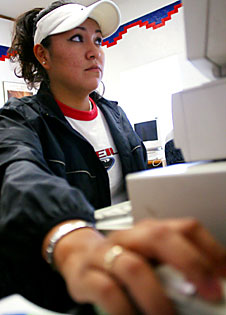 |
|
RANDY METCALF/Arizona Daily Wildcat
|
Pre-physiological sciences sophomore Jackie Slowtalker works on her homework in the Native American Student Affairs center on the second floor of the Nugent building yesterday afternoon.
|
|
By Cara O'Connor
Arizona Daily Wildcat
Wednesday April 16, 2003
Native American students moving from reservations to college life face a variety of challenges, but a center on campus is working to ease the transition.
Native American Student Affairs provides academic services to students, but also supplies a positive social atmosphere.
"I am not really social, so the more times I went there I got to meet more and more people," said Ryan Chee, an aerospace engineering freshman, from the Navajo reservation.
Chee is one of 28 Native American students that live in the O'Odham Ki wing of Graham-Greenlee residence hall.
"The purpose of the wing is to target incoming freshmen or transfer students, students that aren't necessarily familiar with the campus. And it creates a community base for them," said Monica Nuvamsa, senior coordinator of NASA.
Chee's fraternity, Beta Sigma Epsilon, the first Native American fraternity in the western United States, uses the lounge of the NASA Wassaja Student Center for its meetings.
It was in this lounge that Chee met fraternity president Josh Lucio and became involved in the group of which he is now vice president.
Many students also use the center for the computer lab, study room, tutoring and advising services, and as a meeting place.
"It is a good environment with a bunch of kids you can relate to," said resident Jerod Jimmie, an economics sophomore.
Jimmie is a member of the new Native American Student Advisory Council that will take effect this fall. The council is designed to be a leadership development program, Nuvamsa said.
The advisory council members will provide input about improving NASA services and advise individual students, Jimmie said.
Student groups also meet at the Native American Graduate Center on the corner of East Helen Street and North Vine Avenue.
These facilities provide resources for a variety of clubs and organizations, including Alpha Pi Omega (a sorority that is working to become recognized by the university), American Indian Science and Engineering Society, the Red Ink Student Publication and the American Indian Studies Graduate Student Association.
Another service NASA provides is emergency loans for students, without which many students would be forced to drop out, Nuvamsa has said.
NASA provides services and facilities to students with the goal of improving retention and graduation rates.
According to the UA Fact Book, the Native American six-year graduation rate is 25 percent, compared to a total graduation rate of 55 percent, but recent budget cuts have had an impact on NASA's abilities to reach these goals.
"We are trying to create a more streamlined effort and accountability, and still remain focused on our mission, which is the recruitment and retention of Native American students," Nuvamsa said.
Special English 101 and 102 courses that focus on Native American literature are just some of the academic services offered.
"I can understand it better and I think I can relate to the material more," said Kayla Wauneka, a pre-business freshman from the Navajo reservation.
The services that NASA provides are open to all UA students, even though the program's focus is on Native Americans, Chee said.
"The staff helps a lot when we have issues we need to tend to," he said.

